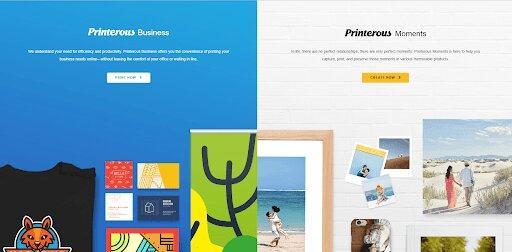
It’s time to step into the 21st century and inject digital technology into internal business processes to stop drowning in piles of paper and gallons of ink. For those open to innovation and ready to join the e-world, an automated Web-to-Print tool offers a new way of direct printing.

Web-to-Print is a prepress process filling the gap between digital content in the global network and commercial print production. Designed primarily for online shops, their clients and in-house graphic designers, this technology allows creating, editing, personalizing, distributing and approving different layouts (business cards, brochures, souvenirs, or any other kind of printed products) in electronic form before printing.
That’s how businesses can manage major marketing efforts via a single tool, optimizing and automating the workflow. When trying to figure out what Web-to-Print solution most specifically fits your business, you should determine the working areas you want to cover: improvement of customer service, expansion of functionality, marketing management, workflow automation or other advancements. Below, you can get acquainted with the main Web-to-Print categories offering unique solutions and benefits for business owners and their customers. Determine your primary goal and choose!
Since this technology provides the entire ecosystem with diversified solutions for each unique case, generally, we can divide business models for Web-to-Print portals into five core categories based on goal-setting parameters:
With Web-to-Print’s ecommerce-style feature, clients can independently create, edit and place print orders on the online portal without the help of the company’s designers or managers.
The mechanism is friendly: the user enters a specialized portal, selects the product he wants to print, and fills in the order parameters as circulation, number of pages, binding type, and more. Customizing a ready template is also possible. Alternatively, a client can load his file (with or without a preflight component), enter delivery information and pay for the order in a convenient way. The Web-to-Print system checks the customer’s file for errors, creates a verification report, calculates the cost of manufacturing taking into account the cost of delivery. Distribution of the issued print orders is carried out either automatically or manually by the typography operator. After printing is complete, the customer receives an email stating his request is ready for shipment.
This plan offers significant advantages including the reduction of human error impact on the process of creating and executing the work, as well as acceleration of numerous routine operations.

Screenshot from Printerous (see on https://www.printerous.com).
The users can easily place print orders on the portal.
Online book printing gives every person the ability to design and print his/her own book from home by uploading a PDF-version of it. Via print-on-demand book services, you can make a paperback or hardcover copy of a book with high-quality photos or pictures. Especially significant is the possibility to deal with e-books. Providers as Lulu.com and PrintingforLess.com widely use this Web-to-Print model, as they not only sell printed products but also allow users to create and sell their books through the website.
 Screenshot from Lulu (see on https://www.lulu.com/). The user can create, publish and sell his/her book on the platform.
Screenshot from Lulu (see on https://www.lulu.com/). The user can create, publish and sell his/her book on the platform.
In comparison with the previous two categories, this Web-to-Print solution focuses on a company’s branding and promotion issues without connection to print service providers. You can create a web storefront and design it according to your business specifics. Your organization is able to control templates, logos, and other materials providing free access to authorized users and maintaining your brand identity.
A Web-to-Print system can be used to make one template suitable and easy-customizable for all your marketing materials. It’s an advantageous option for your marketing departments as now they can manage brand elements more efficiently. Web-to-Print also transforms the way of conducting email marketing campaigns. You can upload data from your CRM system to the module and create personalized print or web mailings with a personal address to each client. A great benefit is centralized billing and reporting showing you how users are spending their print dollars.
The majority of companies are engaged in daily processing of large arrays of information on paper and electronic devices. Inefficient management of documents takes a lot of time and resources. Web-to-Print solutions for creating and managing documents are relevant if:
Use of the Web-to-Print system immensely simplifies digitization of paper documents, recognition and classification of files, streamlines operations and saves time due to well-thought-out workflows. Moreover, it allows you to regularly and correctly distribute digital documents, improving the company’s internal business processes. In total you get reduced information processing costs, boosted workflows, and increased total efficiency.
Preparing and managing print tasks usually takes longer than the printing process itself. Therefore, corporate printing and copying departments often face the same problem: printing equipment cannot be engaged at full capacity which negatively affects overall performance. Automation of the printing workflow through the Web-to-Print solutions allows you to eliminate equipment downtime and continuously use it at full capacity to maintain company production efficiency and competitiveness at an appropriate level. Your employees don’t waste their time on repetitive operations, and your operators immediately receive the order parameters without the necessity to specify them addressed to a client. By adding ready-made templates, you also simplify the process of a client making an order. Finally, the printing process becomes fully automatic with reduced risks of mistakes saving employees time and allowing them to concentrate on other essential tasks.
All Web-to-Print technologies could be divided into two groups depending on the location and the ownership of the software.
The first type is licensed and means the business owner purchased it and located it on rented hosting. This Web-to-Print solution is an essential part of a larger company’s ecosystem which includes CRM, CMS, automated enterprise management systems, and other tools designed for monitoring the work, financial, management, warehouse, transport, and logistics processes. A significant component of this software combination is a CMS-administration system with the next inherent attributes:
In technical terms, licensed software can be developed for any exact enterprise with the help of in-house or external programmers or built by purchased Web-to-Print programs with customized tools and templates for the typography. Although a licensed Web-to-Print seems to be more natural for printing houses, this way of implementation takes a lot of effort and money for installation.
The second type is Web-to-Print based on solutions from third-party IT companies providing software for rent on the principle of Software as a Service (SaaS). In this case, the IT firm is the owner of the Web-to-Print program. It provides the online store platform running the Web-to-Print system, the cloud server space, hosting, administration and service web support, as well as marketing services and advertising of the site.
The IT company processes the entire flow of printing orders through its servers and gives the tools for interaction between printers-clients and the end-customers, providing them mock-ups, technical tasks, and other background information. Furthermore, it ensures feedback from the manufacturers of printed products and passes it to customers to clarify the parameters of their orders and delivery of the finished products to recipients.
The primary benefit users get when using the licensed software besides the low cost of order fulfillment, is the complete security of their business. A holding company is flexible in making decisions and development of the project functionality. Moreover, if a company-provider fails, its Web-to-Print service stops working as well. A business is more reliable when it depends on its own enterprise management but not on third-party partners with monopoly rights to the core programs. SaaS users are afraid to imagine the future of their businesses in the case of bankruptcy or loss of interest of the vendor IT firm.
The Web-to-Print technology is not an absolute panacea, and it does not solve all existing printing-related problems at once. It’s a useful automation tool and an additional channel for attracting customers and entering the B2C market. Without proper personnel training, changes in marketing strategy and production workflow, this technology cannot bring expected success. It helps if you start to reform traditional approaches to business, seriously engage in website promotion and company targeting. Then it makes sense to determine the most suitable Web-to-Print solution and exploit it to its full capacity.